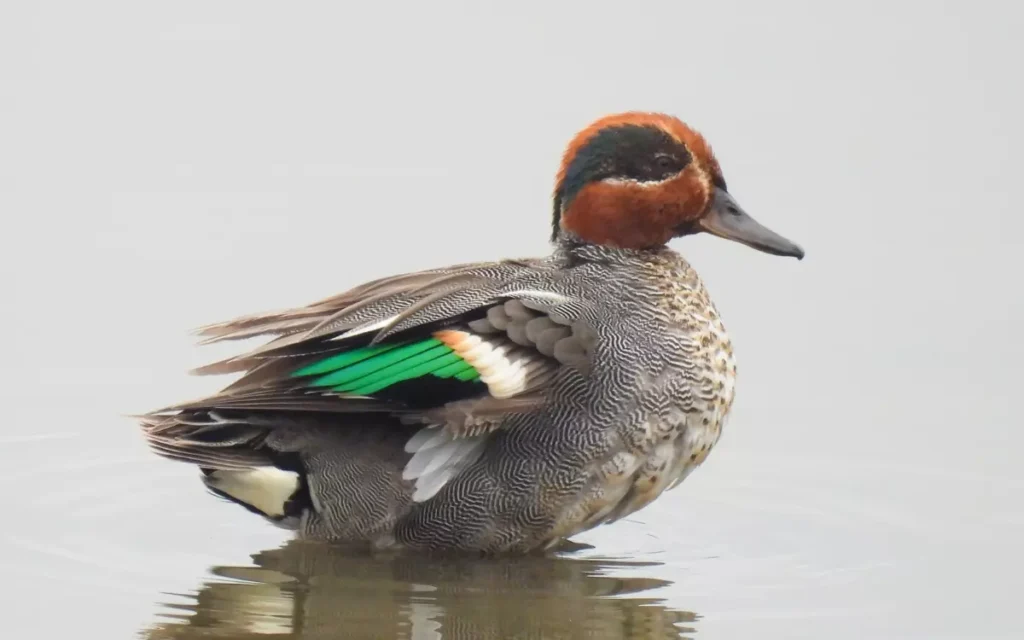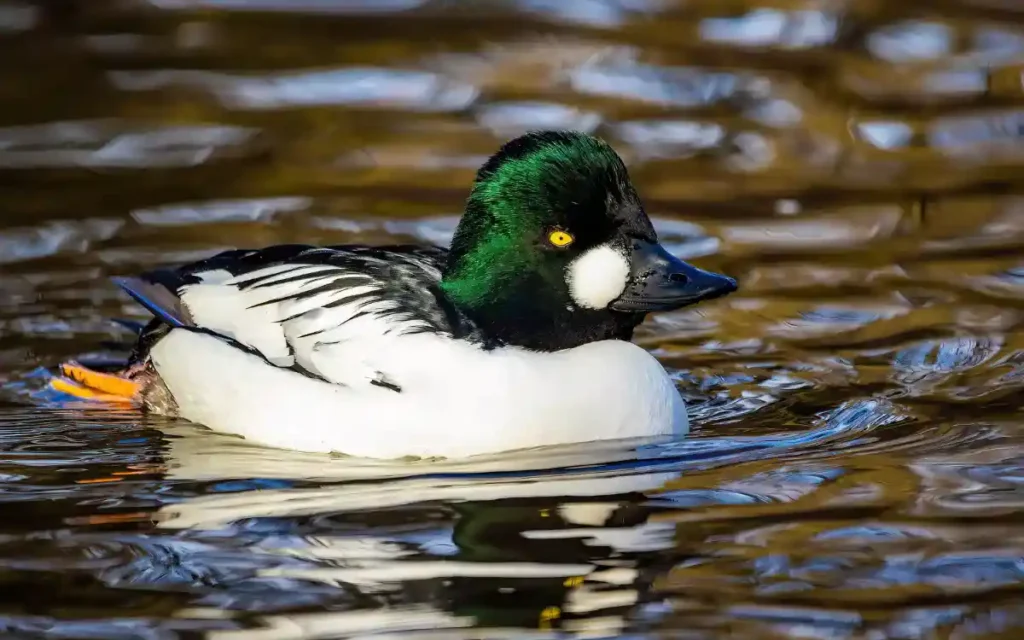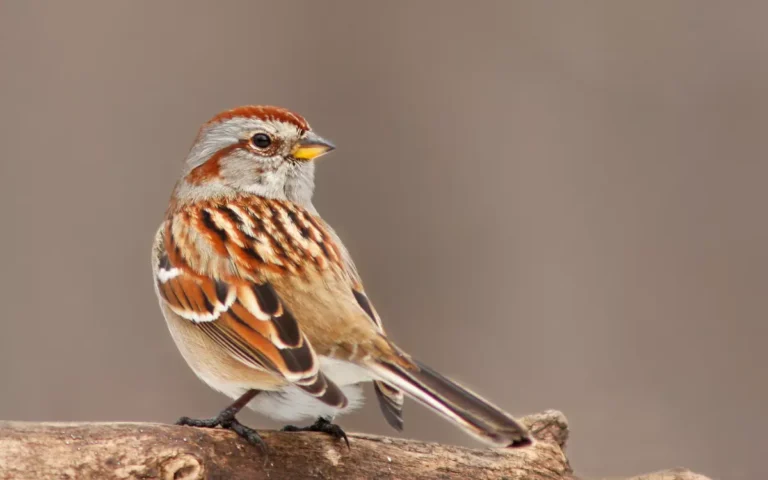10 unique California Ducks with their Info

California ducks are beautiful and diverse, living in wetlands and coasts. Many types thrive here, helping nature by supporting plant growth, controlling insects, and being key in the food web. They play a crucial role in California’s ecosystems.
Learn 10 unique California Ducks:
1. Northern Shoveler:

The Northern Shoveler is a special duck in California. It has a big bill, shaped like a spoon. The male has a green head and a black bill. His sides are brownish-red, and he has a white chest. There are also blue spots on his wings.
Female shovelers look different. They are mostly brown and have a blue patch on their wing. These ducks like to live in shallow water like marshes.
They eat small water creatures and seeds. They use their big bills to filter food from the water. This makes the Northern Shoveler a cool bird to learn about in California.
- Scientific Name :Spatula clypeata
Length: 17.3-20.1 in (44-51 cm) - Weight: 14.1-28.9 oz (400-820 g)
- Wingspan: 27.2-33.1 in (69-84 cm)
2. American Wigeon:

The American Wigeon is a small duck with a unique look. Males have a white forehead and green stripes on the sides of their heads. Their bodies are mostly brownish-grey. Females are brown with greyish heads and white beaks.
These ducks breed in northwest America, Alaska, and western Canada. In winter, they move south to warmer areas in the U.S. and along the Pacific and Atlantic coasts. American Wigeons are often found in lakes, marshes, and fields.
They like eating plants both in water and on land. Sometimes, they also eat insects and small water creatures. This duck’s interesting habits and appearance make it a notable part of California’s wildlife.
- Scientific Name : Mareca americana
- Length: 16.5-23.2 inches (42-59 cm)
- Weight: 19.1-46.9 oz (540-1330 g)
- Wingspan: 30-36 inches (76-91 cm)
3. Wood Duck:

The Wood Duck is a beautiful duck that has a special way of living. It makes its nest in trees, which is unusual for ducks. They like to use holes in trees for their nests, sometimes very high up. These ducks are also happy to use nesting boxes that people put up.
Wood Ducks eat different things like insects, seeds, and fruit. They usually find their food in the water, but sometimes they go on land to eat. Wood Ducks are interesting because of where they live and what they eat.
- Scientific Name : Aix sponsa
- Length: 18.5-21.3 inches (47-54 cm)
- Weight: 16.0-30.4 ounces (454-862 g)
- Wingspan: 26.0-28.7 inches (66-73 cm)
4. Green-winged Teal:

The Green-winged Teal is a small and colorful duck. These ducks are known for being the smallest dabbling ducks in North America. They have a variety of calls, like high-pitched whistles and a “peek-a-peek” sound.
The males look different from the females. They have a soft whistle they use during courtship. The Green-winged Teal likes to eat by dabbling at the water’s surface. They eat things like plants and small water creatures. These ducks are interesting because of their size, sounds, and how they find their food.
- Scientific Name : Anas carolinensis
- Length: 12.2-15.3 inches (31-39 cm)
- Weight: 4.9-17.6 ounces (140-500 g)
- Wingspan: 20.5-23.2 inches (52-59 cm)
Related article:
5. Cinnamon Teal:

The Cinnamon Teal is a duck with a special color and way of living. These ducks are mostly seen in large wetlands in California. The males are easy to spot with their cinnamon-colored bodies and red eyes.
Females are brown with black bills. Cinnamon Teals build their nests in places with lots of plants near the water. They eat by dabbling at the water’s surface for plants and small creatures. These ducks are interesting because of their bright color and where they choose to live and eat.
- Scientific Name : Anas cyanoptera
- Length: 14.2-16.9 inches (36-42.8 cm)
- Weight:11.8-14.1 ounces (335-401 g)
- Wingspan: 21.3-22.4 inches (54-57 cm)
6. Gadwall:

The Gadwall is a kind of duck with unique habits. These ducks don’t nest in trees but prefer marshy areas. They like to build their nests on the ground, hidden among tall plants. The males look mostly gray with a black back and a white patch on their wings. Females are brown with a bit of white. Gadwalls mostly eat plants from the water, but they can also walk onto land to find food. They are special because of where they nest and what they eat. They’re different from other ducks that might choose trees for nesting.
- Scientific Name :Mareca strepera
- Length: 18.1-22.4 inches (46-57 cm)
- Weight:17.6-44.1 ounces (500-1250 g)
- Wingspan: 33.1 inches (84 cm)
7. Common Goldeneye:

The Common Goldeneye is a unique duck with interesting nesting habits. Unlike many other ducks, the female Common Goldeneye often lays her eggs in the nests of other ducks. These ducks are not usually seen nesting in trees. The males are mostly white with black backs and green heads, and they have big white spots near their eyes.
Females have brown heads and gray bodies. What makes the Common Goldeneye special is its whistling wings when flying and the male’s fancy displays to attract a mate. They mostly eat fish, making their diet different from many other duck species.
- Scientific Name :Bucephala clangula
- Length: 15.8-20.1 inches (40-51 cm)
- Weight:21.2-45.9 ounces (600-1300 g)
- Wingspan: 30.3-32.7 inches (77-83 cm)
8. Common Merganser:

The Common Merganser is a special duck with cool features. The males have shiny green heads and bright red bills. Females have red-brown heads with a white patch under their chin.
Both males and females have long, pointed bills that help them catch fish, which is their main food. They are different from many ducks because they eat mostly fish. The Common Merganser’s unique look and diet make it an interesting bird in California.
- Scientific Name : Mergus merganser
- Length: 21.3-28 inches (54-71 cm)
- Weight:2-4.6 lbs (900-2100 g)
- Wingspan: 34-38 inches (86-97 cm)
Related article: 26 Species of Sparrows in California You can see
9. Eurasian Wigeon:

The Eurasian Wigeon is a duck that’s not very common in California, but sometimes you can see it here. They usually live in Northern Europe and Russia. When they do visit the U.S., they come in winter.
Males have small black and white bills and a blue bill with a black tip. They also have a lot of feathers that are different colors. The Eurasian Wigeon is special because it’s not seen in California very often, and its colors and the places it comes from make it interesting.
- Scientific Name :Mareca penelope
- Length: 16.5-20.5 inches (42-52 cm)
- Weight: 17.6-33.5 ounces (500-950 g)
- Wingspan: 28–31 inches(71–80 cm) .
10. Barrow’s Goldeneye:

The Barrow’s Goldeneye is a unique duck that lives in northern places like Alaska and Greenland. During the winter, they travel south to warmer areas, including California.
This duck is known for moving long distances between its summer and winter homes. The Barrow’s Goldeneye likes to live in places where it’s cold most of the year but heads to milder places when it gets too cold. This traveling habit and where they live make the Barrow’s Goldeneye an interesting bird to learn about.
- Scientific Name :Bucephala islandica
- Length: 16.9-19.1 inches (43-48.4 cm)
- Weight: 20.5 -46.6 ounces (580 -1320 g)
- Wingspan: 27.6-28.7 inches (70-73 cm)
Habitats and Migration Patterns:
Ducks in California have homes in freshwater, like lakes and rivers, saltwater in the ocean, and marshlands. Each place offers them something special. Freshwater has lots of plants and bugs to eat, saltwater is good for ducks that like fish, and marshlands are a mix of both.
These ducks also travel a lot. They have migration patterns where they move to different places in different seasons. When it’s warm, they go to cooler places to have babies. When it’s cold, they fly to warmer places.
Wetlands and coastal areas in California are super important for ducks. They give the ducks safe places to live, find food, and raise their little ducklings. Keeping these places safe helps the ducks a lot. They’re like big, natural homes for the ducks!
Conservation Efforts and Challenges:
Ducks in California have their ways of making nests and taking care of their babies. Most ducks build their nests near water, on the ground, or hidden in tall grass.
They use leaves and grass and line them with soft feathers. The mommy duck lays eggs and keeps them warm until they hatch. This is called incubation. It takes about 25 to 30 days for duck eggs to hatch.
Once the ducklings are born, they can walk and swim almost right away. The mommy duck leads them to water to find food.
Some ducks, like the Wood Duck, nest in tree holes or use nesting boxes. And, the Common Goldeneye sometimes lays eggs in other ducks’ nests! Each type of duck has its special way of nesting and caring for its ducklings.
Conservation Efforts and Challenges:
Ducks in California face challenges because their homes, like wetlands, are disappearing. This is called habitat loss, and it’s bad for ducks. Groups like Ducks Unlimited are working hard to save these places. They protect land and make new homes for ducks.
But, saving ducks and their homes is tough. It’s hard to stop places from changing and to make sure there’s enough space for all the ducks. These groups are really important because they help keep ducks safe and make sure they have places to live, eat, and raise their ducklings.
Human Interaction and Hunting Regulations:
In California, how people interact with ducks, especially through hunting, is important for managing the duck population. There are special hunting seasons and rules that help make sure hunting is safe and doesn’t harm too many ducks. These rules are there to keep the number of ducks just right.
But, things people do, like building and polluting, can be bad for ducks. These activities can destroy their homes and make it hard to find food. Following hunting rules and caring for nature are important. This not only helps ducks but also other birds, like the goose California, which live in similar places. Taking care of ducks means taking care of all these birds and their homes.
FAQs on California Ducks:
Q: What is the most common duck in California?
A:The Mallard is often considered the most common duck in California. It’s easily recognized by the male’s bright green head.
Q: How do ducks contribute to California’s ecosystems?
A:Ducks help by eating pests, spreading seeds, and their droppings fertilize the soil. They’re part of the food chain, too, as prey for other wildlife.
Q: What are the major threats to ducks in California?
A:The biggest threats are habitat loss due to development, pollution, and climate change. These issues make it hard for ducks to find food and safe places to live.
Q: How can individuals contribute to duck conservation?
A:People can help by keeping natural areas clean, supporting conservation groups, and following rules that protect wildlife. Even creating duck-friendly habitats in your community helps!
Q: What kind of duck is in California?
A:California has many duck species, like the Mallard, Wood Duck, Northern Shoveler, and Cinnamon Teal. Each has its unique features and habits.
Q: Do California ducks migrate?
A:Yes, many ducks in California migrate. They travel to warmer areas in the winter and return to their breeding grounds in the spring.
Q: Is California good for duck hunting?
California is popular for duck hunting, especially in the Central Valley. But it’s important to follow the state’s hunting regulations and seasons to ensure sustainable hunting practices.
Conclusion :
California’s ducks are a vital part of its ecosystems, offering beauty and balance. Protecting their habitats ensures these ducks continue to thrive and enrich California’s natural diversity.






